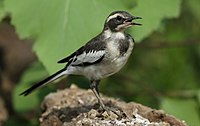| African pied wagtail | |
|---|---|

| |
| M. a. vidua, Uganda | |
| Conservation status | |
 Least Concern (IUCN 3.1) | |
| Scientific classification | |
| Domain: | Eukaryota |
| Kingdom: | Animalia |
| Phylum: | Chordata |
| Class: | Aves |
| Order: | Passeriformes |
| Family: | Motacillidae |
| Genus: | Motacilla |
| Species: | M. aguimp |
| Binomial name | |
| Motacilla aguimp Temminck, 1820 | |
The African pied wagtail, or African wagtail, (Motacilla aguimp) is a species of bird in the family Motacillidae.
Description

A striking black and white wagtail with black upperparts contrasting with white underparts, it has a white supercilium and a white patch in the folded wing. Juvenile birds are greyer, while birds of the nominate subspecies show grey flanks. They are 20 cm (7.9 in) long.
Distribution
The African pied wagtail is found in sub-Saharan Africa from the Eastern Cape north to extreme southern Egypt and from Guinea to western Eritrea and Somalia. It is a vagrant to Burkina Faso, Gambia, Mauritania, and the Western Cape.
Habitat
The African pied wagtail inhabits subtropical or tropical, seasonally wet or flooded, lowland grassland, rivers, and sometimes freshwater marshes. In some areas, it is commensal with humans in towns and villages.
Biology
In Malawi, African pied wagtails start breeding before the rains and continue to breed into the rainy season; they breed during six months, peaking in March and October. Both the males and females participate in nest building, but only the females incubate, and both sexes feed the young. The mean clutch in Malawi was found to be 3.9 eggs.
The African pied wagtail is monogamous; the cup-shaped nest is lined with grass and feathers and is usually situated near water in a convenient tangle of sticks. In settlements, the nest may be located on buildings. The nests of the African pied wagtail are parasitised by the red-chested cuckoo Cuculus solitarius and the diderick cuckoo Chrysococcyx caprius. The chicks have been recorded as prey of Burchell's coucal Centropus burchellii.
The African pied wagtail is mainly insectivorous, but also feeds on other invertebrates, grass seeds, tadpoles, small fish, and scraps of human food.
Etymology
The scientific binomial for the African pied wagtail is Motacilla aguimp; Motacilla, the name of the genus containing all but the forest wagtail of Asia, is from the Latin for a "little mover", while the specific name aguimp is the native name of the species "Les Namaquois les appellent a-guimp, nom composé de deux syllabes précédées chacune d'un clappement de langue, et qui signifie coureur de grève" ("The Namaquois call them a-guimp, a name made up of two syllables each preceded by a click of the tongue, and which means shore runner").
Taxonomy and subspecies
Among the wagtails, the African pied wagtail is most similar in appearance to the recently discovered Mekong wagtail, and genetic evidence suggests that the two are each other's closest relatives and are each just as related to other black-and-white wagtails such as the white wagtail M. alba complex or the white-browed wagtail M. maderaspatensis.
Two subspecies of the African pied wagtail are recognised:
- M. a. aguimp – the Northern Cape and Free State provinces in western South Africa, and along the Gariep River from southernmost Lesotho to southernmost Namibia
- M. a. vidua – the remainder of its range
References
- ^ BirdLife International (2018). "Motacilla aguimp". IUCN Red List of Threatened Species. 2018: e.T22718366A132117671. doi:10.2305/IUCN.UK.2018-2.RLTS.T22718366A132117671.en. Retrieved 11 November 2021.
- "IOC World Bird Lists Version 6.4 Waxbills, parrotfinches, munias, whydahs, Olive Warbler, accentors & pipits". IOC World Bird List v 6.4 by Frank Gill & David Donsker (Eds). International Ornithological Congress. Retrieved 22 October 2016.
- Sinclair, Ian; Ryan, Peter (2003). Birds of Africa south of the Sahara. Struik. p. 364. ISBN 978-1-8687-2857-2.
- ^ "African Pied Wagtail Bontwikkie Motacilla agiump" (PDF). The Atlas of Southern African Birds. Animal Demography Unit. Retrieved 22 October 2016.
- "African pied wagtail". Beauty of Birds. Archived from the original on 22 October 2016. Retrieved 22 October 2016.
- Nhlane, M.E.D. (1990). "Breeding biology of the African Pied Wagtail Motacilla aguimp in Blantyre, Malaŵi (abstract)". Ostrich. 61 (1–2): 1–4. doi:10.1080/00306525.1990.9633929.
- "Bird of the week – Week 40 : African pied wagtail". Wordpress. 10 October 2010. Retrieved 22 October 2016.
- ^ "Motacilla aguimp (African pied wagtail)". Iziko Museums of South Africa. Archived from the original on 3 October 2011. Retrieved 22 October 2016.
- "Dictionnaire des sciences naturelles 21: 266". F. G. Levrault. 1821. Retrieved 21 April 2024.
- "Mekong Wagtail". Oriental Bird Club. Retrieved 22 October 2016.
- "African Pied Wagtail Motacilla aguimp Temminck, 1820". Denis Lepage. Retrieved 22 October 2016.
External links
- African pied wagtail - Species text in The Atlas of Southern African Birds.